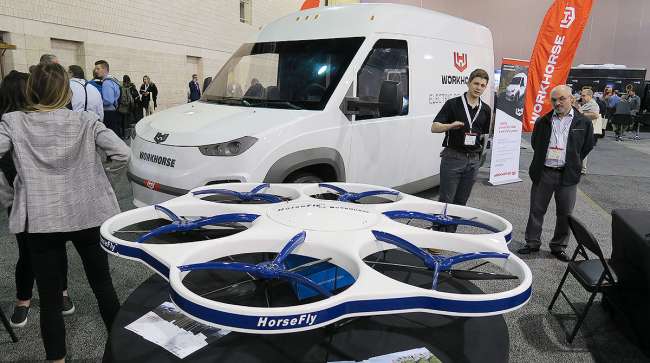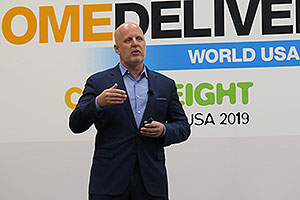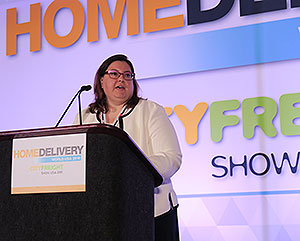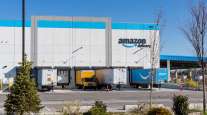Managing Editor, Features and Multimedia
Retailers, Logistics Firms Expand Final-Mile Delivery to Meet Rising E-Commerce Expectations

PHILADELPHIA — Retailers and transportation providers are embracing a blend of final-mile delivery strategies to keep pace with rapidly shifting online shopping habits.
As e-commerce continues to expand, companies increasingly are offering options such as home delivery and installation of heavy appliances and in-store pickup of fresh groceries ordered online, industry leaders said at the Home Delivery World trade show here April 4-5.
“Consumers are getting more and more comfortable with buying everything online, including items they were hesitant about before,” said Dan Walsh, president of XPO Logistics’ last-mile business, which provides home deliveries of bulky goods such as appliances, furniture, fitness equipment and building supplies.

Walsh says consumers have become more comfortable with online purchases of heavy and bulky items. (Seth Clevenger/Transport Topics)
Walsh cited a recent XPO-commissioned survey indicating that more than a third of U.S. consumers now are willing to buy a bulky item online. “That wasn’t always the case,” he said.
Online shoppers also are increasingly utilizing the latest wave of consumer technology as they make purchasing decisions. The survey found that 35% of consumers are likely to use a smart speaker to check on delivery status.
“By 2020, the average person will have more conversations with bots than with their spouse,” Walsh said.
That same year, 100 million consumers will be using augmented reality to make purchase decisions, he said. Buyers could use the technology to visualize how a new couch would look sitting in their living room, for example.
“What we’re trying to do is get in front of emerging consumer behavior,” Walsh said.
XPO arranges about 40,000 deliveries a day to homes, businesses and new construction sites, he said.
The grocery sector represents another major growth area for e-commerce and final-mile delivery.
Giant Food Stores, for one, has taken steps to unify its in-store and online shopping experiences by offering home delivery as well as pickup of groceries ordered online.
“It doesn’t matter if you’re in the city, on a farm or in the countryside, customers want options,” said Matt Simon, Giant’s vice president and chief marketing officer. “I don’t believe they’re ever going to pick just online or just the store. At some time in the future, they’ll be merging them.”
Earlier this year, the grocery retailer launched its Giant Direct e-commerce brand in partnership with sister company Peapod, which provides home delivery of groceries ordered online.
In addition, Giant customers can place online orders, then drive to an e-commerce center and have their bagged groceries loaded.
Giant Food Stores, based in Carlisle, Pa., operates 170 stores in Pennsylvania, Maryland, Virginia and West Virginia. The company is part of the Ahold Delhaize supermarket chain based in Zaandam, Netherlands.
Emerging technologies also are poised to play a role in the evolution of the final mile. Show displays ranged from delivery logistics software to electric-powered and autonomous vans and delivery drones.
XPO plans on investing more than $550 million per year in technology to increase visibility and enhance efficiency through automation.
“We believe that’s a critical differentiator,” Walsh said.
The company recently extended last-mile delivery capabilities to its digital freight marketplace, XPO Connect. The platform can offer XPO’s shipper customers greater visibility into the final-mile deliveries, as well as more control over the delivery process, he said.
Meanwhile, XPO’s independent delivery contractors will be able to see what loads are available, follow payment activity and see potential delays or obstacles on their routes.

Bartashus says consumer expectations have changed dramatically with the advent of e-commerce. (Seth Clevenger/Transport Topics)
Jennifer Bartashus, a senior equity research analyst at Bloomberg Intelligence, said it’s easy to lose sight of how much e-commerce already has progressed over the years.
She recalled a time in 2003 when she had to travel to multiple stores within a 200-mile radius to find fabric for a bridesmaid dress because none of those stores had inventory management systems tracking what was available.
Fast-forward to 2019, when buyers can purchase a pair of shoes online and they arrive at their home two days later, with e-mail and text alerts providing updates on the delivery each step of the way.
“Consumer preferences continue to evolve at an unprecedented pace,” Bartashus said. “Expectations on breadth of assortment, speed of order fulfillment, delivery options, white-glove service and customer support are all shifting, testing the flexibility and capacity of supply chains and last-mile delivery solutions.”
Customers’ increased delivery expectations vary though, depending on the type of product they order, said Roman Sobieri, head of shipping, listing management and payment operations at Etsy, an e-commerce site where individual sellers offer handmade and vintage goods.
In most cases, buyers are willing to wait longer for unique, custom-made products, “but for off-the-shelf products, the tolerance is much, much lower,” he said.
Online shoppers expect speedy delivery of their purchases for little or no cost, as well as transparency and the ability to return products, but at the end of the day, they don’t care about the complex logistics planning and execution needed to make that possible, Sobieri said.
“They’ve seen the magic happen,” he said. “They don’t care how it works, but they expect it now.”



